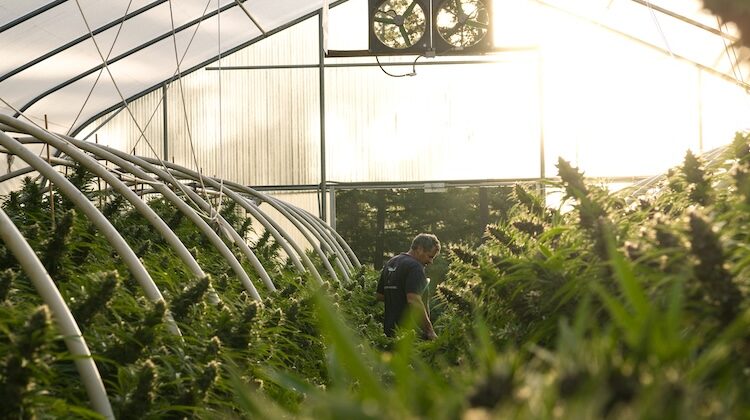
Photos by Ben Neff
Nestled in the rugged hills of Northern California, the Emerald Triangle—comprising Humboldt, Mendocino, and Trinity counties—has earned its reputation as the cannabis capital of not just the United States but the world. With its varied geography, ideal climate, and tight-knit farming community, this unique region is the birthplace of some of the world’s finest cannabis. But how did this remote, natural paradise rise to prominence, and what does the future hold for the legacy farmers who built its legendary reputation?
The Birth of the Cannabis Capital
The roots of the Emerald Triangle’s cannabis culture can be traced back to the 1960s and 1970s when a wave of back to the landers sought refuge in the remote hills of Northern California. The movement was a countercultural phenomenon that drew many people from urban areas like San Francisco. Disillusioned with urban life, consumerism, and societal norms, back to the landers were drawn to rural areas like Humboldt County where they could live more self-sufficiently and reconnect with nature. The area’s isolation, with its dense forests, steep mountains, and access to natural resources, made it the perfect sanctuary for people looking to live off the grid—away from prying eyes of authorities. Cannabis cultivation naturally took hold and became a central part of life for many. But it wasn’t just the isolation that made the Emerald Triangle ideal for growing.
The Emerald Triangle’s microclimates, influenced by its elevation, proximity to the coast, and inland valleys, offer a mix of hot, dry days and cool, damp nights. These conditions allow cannabis plants to thrive in ways that are hard to replicate anywhere else in the world. The combination of warm daytime temperatures and cool nights helps the plants develop rich terpene and cannabinoid profiles, making the cannabis produced here distinct in both flavor and potency.
John Casali has deep roots in Humboldt County, where he’s spent decades cultivating cannabis on Huckleberry Hill Farms. Reflecting on the region’s distinctive growing conditions, Casali told The Emerald™, “The mountainous regions of the Emerald Triangle have created a diverse array of microclimates that have enabled our unique genetics to thrive. The hot days and cool nights produce an incredible terpene and cannabinoid profile that I believe cannot be replicated anywhere else in the world.”
This exceptional climate, paired with the region’s varied geography, allowed cannabis farmers to experiment and perfect their strains, passing down knowledge through generations. Environmental factors, combined with a deep sense of community and shared expertise, laid the foundation for the region’s rise to prominence.
Building a Legacy: The Importance of Community
As the demand for cannabis increased over time, the Emerald Triangle became home to more than just farmers—it became a close-knit network of individuals united by a shared commitment to quality, sustainability, and tradition. The region’s isolation fostered a unique sense of community where trust was essential, as cannabis cultivation often remained underground due to legal restrictions.
As Casali describes it, “Our way of life consisted of an understanding that most everyone in the Emerald Triangle grew cannabis. We also understood that ‘loose lips sank ships,’ and trust amongst your closest inner circle was the only way to ensure the safety of your family.”
The trust that existed among farmers allowed them to help one another through the inevitable challenges that came with underground cultivation, whether dealing with harsh weather, navigating the legal risks, or refining their craft. Over time, this sense of community became the backbone of the Emerald Triangle’s cannabis culture.
The Green Rush: Prosperity and Growing Pains
By the late 1980s and early 1990s, the Emerald Triangle had built a reputation for producing the highest-quality cannabis, renowned for its potency and unique characteristics. Cannabis grown in the region became a sought-after commodity on the illicit market, with its demand pushing prices to new heights. This sparked a Green Rush, as outsiders, drawn by the promise of profits, moved into the area, eager to capitalize on the growing market.
However, the influx of new growers created friction within the community. Many of these newcomers did not share the same commitment to sustainability or reverence for the land that the original farmers held dear.
“As the demand for cannabis grew, a large group of outsiders, known as green rushers, infiltrated the area. Most of these folks didn’t care about the environment like the locals, and together, we did what we could to force them to either change their ways or move out of the area,” Casali recalled.
Despite this influx, the farmers who remained committed to preserving the region’s traditions and ecological balance continued to produce cannabis that stood apart from the rest—a product deeply rooted in the Emerald Triangle’s unique landscape.
The Shift to Legalization: New Challenges, Same Resilience
When California legalized cannabis in 2016, the Emerald Triangle faced new opportunities and challenges. While legalization allowed farmers to operate aboveboard for the first time, it also introduced burdensome regulations and costs. Navigating the legal landscape, securing licenses, and adapting to market oversaturation created new hurdles for farmers who had spent decades cultivating cannabis outside the regulatory framework.
The shift from an underground operation to a legal one has required many legacy farmers to adapt. The over-saturation of the market, combined with the high costs of compliance, has been particularly difficult for smaller farms. But while times are tough, the Emerald Triangle’s legacy farmers are resilient and remain steadfast in their commitment to the quality of the product.
“Anyone who thinks it’s easy to grow in the Emerald Triangle hasn’t spent a season out here. Incredibly hot and dry conditions, the constant threat of wildfire, driving hours for your groceries, working in harmony with wildlife, off-grid living, limited cell phone and internet access. Not to mention the threat of violent law-enforcement raids, which are still ongoing to this day,” Jenn Procacci, co-owner of WildLand Cannabis shared. “Legacy farmers have been navigating these challenges and more for generations that the average grower elsewhere wouldn’t last a week in, and we’ve been churning out the absolute finest quality cannabis and creating legendary world famous genetics to boot. Diamonds are forged under pressure!”
The Future: Embracing Legacy and Adaptation
Looking ahead, the farmers of the Emerald Triangle are focused on preserving what has made their cannabis so special: its legacy genetics. These unique strains, developed over decades, are one of the region’s greatest assets and the key to its future success in an increasingly commercialized market.
For farmers like Casali, protecting these one-of-a-kind genetics is vital for their future. “We’re realizing how important those legacy genetics that nobody else in the world has is to our survival. We truly have something very unique here.”
The future of the Emerald Triangle’s cannabis legacy is about more than just weathering the storm of legalization—it’s about continuing a tradition of excellence. As Procacci puts it, “Legacy farmers are some of the toughest and hardest working people I’ve met in my life. We will persevere.”
A Legacy of Craftsmanship and Resilience
While the industry continues to evolve, the resilience of the farmers who call this region home ensures that the Emerald Triangle will remain the heart of cannabis cultivation. It is a place where tradition and innovation go hand in hand, and the legacy of world-class cannabis will continue to thrive for generations to come.



Leave a Reply